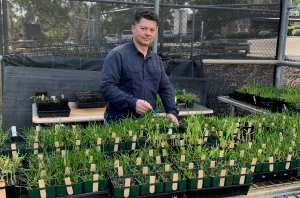|
Australia - Testing reveals need to control herbicide resistance
Australia
September 10, 2020

Peter Boutsalis and his team have detected increasing rates of glyphosate resistance in randomly collected ryegrass samples. Photo: Courtesy Peter Boutsalis
A long-term Grains Research and Development Corporation (GRDC) program monitoring herbicide resistance in significant weed species has revealed increasing rates of resistance to a wide range of herbicides.
This means growers will need to consider tactics such as double-knock spraying and harvest weed seed control to help them keep resistant ryegrass populations at bay.
Researchers from the University of Adelaide collected ryegrass seed from 325 randomly selected paddocks across parts the southern growing region between October and December 2019. These were grown in pots and sprayed with herbicides at label rates in May and June 2020.
Researcher Dr Peter Boutsalis said herbicide resistance had clearly increased over the program’s 2009, 2014 and 2019 surveys.
“Our results from the lower Eyre Peninsula, upper Eyre Peninsula and south-western Victoria all show increasing resistance to various herbicides,” he said.
“For example, the ryegrass samples from south-western Victoria showed no resistance to trifluralin in 2009, but that increased to two per cent of samples in 2014 and reached 17 per cent in 2019.
“On the lower Eyre Peninsula, the rates of resistance to trifluralin were 10 per cent in 2009, then 51 per cent in 2014 and 66 per cent in 2019.”
Dr Boutsalis said the increasing rates of resistance were not restricted to any one herbicide group or region. As strains with a specific resistance evolved, they quickly established themselves in the local area.
“One of the most concerning increases in resistance was to glyphosate in south-western Victoria where resistance was detected in four per cent of randomly collected ryegrass samples in 2014 but 39 per cent of the samples collected in 2019,” he said.
“Resistance to imidazolinone herbicides has also increased to alarming levels.
“On the upper Eyre Peninsula, the incidence of resistance to imidazolinone herbicides was 30 per cent of samples in 2009, rose to 39 per cent in 2014 and comprised 88 per cent in 2019.”
Dr Boutsalis said identifying and keeping herbicide-resistant weeds at manageable levels was essential for the long-term viability of chemical actives like glyphosate in Australian cropping systems.
“If the weeds grow through to flowering their pollen can carry the resistant gene across a wide area via wind dispersal, plus the resistant seeds can be spread via several methods including farm equipment and livestock,” he said.
“Undetected resistance on one farm can lead to that strain getting established, which creates a problem for surrounding paddocks.
“Growers who are aware of their resistance problems know to focus on tactics such as harvest weed seed control and double-knock spraying.
“If they treat every glyphosate survivor with paraquat over the next two seasons, they should be able to significantly reduce weed populations.”
Growers and agronomists can send living plants collected from paddocks between autumn and early spring for resistance testing (‘Quick Test’). Additionally, seeds collected at harvest time can be sent for testing over summer and reporting in early autumn.
Further information is available from Plant Science Consulting in Adelaide or the Charles Sturt University Plant Interactions Research Group.
More information on herbicide resistance and weed management is available in the GRDC Integrated Weed Management Manual and via the GRDC-supported WeedSmart portal.
WeedSmart is the ‘single industry’ multi-channel platform for information on combating cropping weeds and herbicide resistance in Australia.
More news from: GRDC (Grains Research & Development Corporation)
Website: http://www.grdc.com.au Published: September 10, 2020 |
|
The news item on this page is copyright by the organization where it originated
Fair use notice |